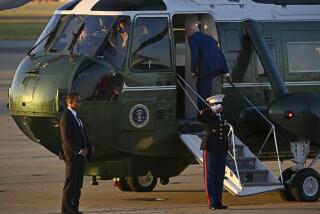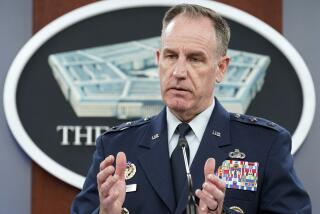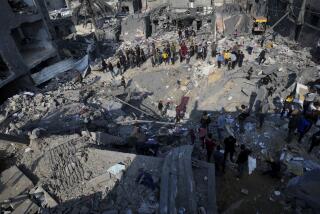300 Iraq Scuds Missing, U.N. Team Reports : Arms control: But the inspectors do not go so far as to accuse Baghdad of hiding the missiles.
- Share via
UNITED NATIONS — Accusing Iraq of a pattern of misinformation, concealment and lack of cooperation, United Nations inspectors reported on Friday that President Saddam Hussein’s government has failed to account for 300 Scud missiles that once were in its arsenal.
But the inspectors, in a report detailing their first six months of work, did not go so far as to charge Iraq with concealing the Scuds, which proved to be Hussein’s most lethal weapon during the Gulf War.
The report said the United Nations is still awaiting “a satisfactory accounting for all the relevant missiles obtained or constructed by Iraq and a full disclosure of plans and progress in future ballistic missile development.”
Johan Molander, spokesman for the special U.N. commission inspecting Iraq’s weapons of mass destruction, elaborated, saying that the United Nations knew that Iraq had obtained 800 Scud missiles from the Soviet Union before the war. After totaling the Scuds fired during the war or destroyed by the United Nations afterward, there were still 300 missiles unaccounted for.
But Molander said there are “shades of opinion” among the inspectors about the missing Scuds. Some inspectors believe they could have been destroyed in tests or in launchings.
The report, submitted to the Security Council by commission chairman Rolf Ekeus, a Swedish diplomat, made it clear that Iraq can still not be considered in full compliance with the U.N. cease-fire resolution that requires it to destroy all its long-range missiles and all its capability in nuclear, chemical and biological warfare.
Under terms of that resolution, the U.N.-imposed sanctions remain in place until Iraq is considered in full compliance.
In any case, according to the inspectors, it will take the U.N. and Iraq 18 months to two years to destroy all the chemical warfare materials, even with the cooperation of the Iraqi government.
The report made it clear that Iraq’s well-publicized attempts to prevent the inspectors from collecting material on its nuclear warfare program had made the United Nations suspicious about Iraq’s intentions in the other fields as well.
“The elements of misinformation, concealment, lack of cooperation and violation of the privileges and immunities of the (inspectors) have not created any trust in Iraq’s intentions,” the report said. “They have had a negative impact on relations with Iraq and have engendered an atmosphere of profound skepticism, particularly in the nuclear area; this atmosphere has to some degree contaminated the other three areas.”
The U.N. report said that “a change in the attitude of Iraq to one of candor . . . and cooperation at all levels is probably the one single element that could contribute most substantially” to a lifting of the sanctions.
In the six months since the end of the Gulf War, inspectors from the U.N. commission and the International Atomic Energy Agency have made 20 trips to Iraq--seven nuclear warfare inspections, six chemical warfare inspections, five ballistic missile inspections and two biological warfare inspections.
Assessing work in the four areas, the U.N. commission said:
- Its nuclear teams had “finally obtained conclusive evidence of a nuclear weapons development program” that could have built a nuclear weapon in 12 to 18 months.
- Iraq has acknowledged possession of 46,000 munitions filled with deadly chemicals. Under U.N. supervision, the Iraqis have destroyed 11,829 of these, but destruction of the munitions will go on until 1993. Decisions still must be made about the safest way to destroy the chemicals.
- Inspectors found “conclusive evidence that Iraq was engaged in an advanced military biological research program.” But there was no evidence that Iraq had actually built any biological weapons.
- Inspection teams have supervised the destruction of 62 missiles, 18 Scud launching pads, 10 launchers, 11 decoy missiles, 32 ballistic warheads, 127 missile storage support vehicles, a substantial amount of rocket fuel, a supergun, components for two other superguns and a ton of supergun propellant.
The U.N. report still did not include the long-awaited list of countries and corporations that supplied materials to Iraq for its enormous arsenal of weapons of mass destruction.
But Molander said the inspectors had found evidence that the Iraqis had compiled an inventory of equipment that could be used for civilian and military programs. The Iraqis then ordered this equipment on behalf of civilian companies that could use it, diverting it to military use once it arrived.
The commission was recently charged with the added task of monitoring Iraq indefinitely.
More to Read
Sign up for Essential California
The most important California stories and recommendations in your inbox every morning.
You may occasionally receive promotional content from the Los Angeles Times.












